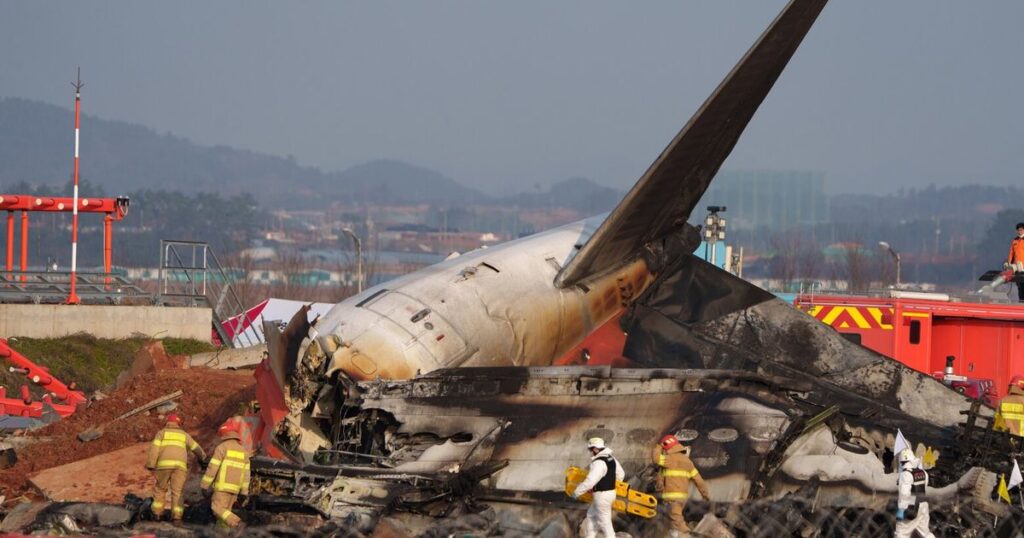SEOUL, South Korea — Minutes before Jeju Air Flight 2216 crash-landed and killed 179 people in December, the pilots appeared to have shut down the engine less damaged by a bird strike seconds earlier, leaving the plane running on just one damaged engine that caught fire, investigators have found.
The shutdown likely led to a loss of electrical power and the removal of the aircraft’s main source of thrust, hampering the pilots’ ability to land, according to a person familiar with the investigation.
With limited electrical power, the aircraft tried to land without its landing gear down. The plane slid on its belly, slammed into a concrete wall at the end of the runway and burst into flames. Two flight attendants survived. All passengers and other crew members were killed.
The latest findings, some of which were included in an official interim report shown to families of the victims Saturday, have increased scrutiny of how the pilots handled the emergency landing after the plane was struck by the birds, damaging both engines. Experts in the United States said it raised the possibility that the pilots misidentified the engine that needed to be shut down, although they cautioned that it was too early to draw such conclusions.
“If the pilots lost their displays after the bird strike, they may have had no clear indication of which engine was damaged,” said Joe Jacobsen, an aviation safety expert who has worked at both Boeing and the Federal Aviation Administration. He emphasized the need for detailed cockpit data before drawing conclusions.
The plane’s flight recorders, which require electrical power to operate, stopped working five seconds after the left engine was shut down. That left gaps in information over what happened in the remaining few minutes, during which the pilots initiated another go-around and made the emergency landing. Outstanding questions include why the landing gear was not manually deployed after the plane lost much of its power and whether the plane’s backup generator was working.
The report said no preexisting defects had been found in either engine, according to an analysis conducted by American, French and South Korean investigators from May to June.
The interim report triggered protests by relatives of the victims who were privately briefed by officials Saturday. Family representatives said the report provided insufficient evidence about the cause of the crash, while appearing to blame the birds and the pilots.
Officials abruptly canceled a news conference to publicly release the findings after some relatives disrupted the event, even pushing an official out of the room to prevent it from happening.
Ko Jae-seung, a member of the relatives’ delegation who shared with The New York Times what he had learned in the officials’ 30-minute presentation, said many families believed the findings were premature and lacked sufficient supporting evidence.
Ko said an investigator took questions from the families, extending the briefing, but could not answer many of them, leaving relatives unconvinced by their explanations.
Investigators told the families that after the bird strike, both engines were operating with vibration, which is a potential sign of damage, and the report confirmed feathers were found in both engines.
The right engine was also experiencing a surge — damage to its compressor — that caused fire and black smoke — officials said. But the right engine was found to still have power just before the plane landed on its fuselage, officials added.
The engine could have been producing some thrust because of the combustion from the fire, U.S. aviation experts said, but not enough to power the plane.
Earlier fatal crashes — including the 1989 Kegworth Air disaster and the 2015 TransAsia Airways crash — showed that misidentifying a failing engine can lead to catastrophic outcomes. In both cases, crews shut down the functioning engine, leaving the aircraft without enough power to continue flying. Dozens of people died in each crash.
Aviation experts said a loss of engine power diminishes thrust and electrical generation. Without those systems, pilots must rely on manual controls and emergency protocols to maintain flight.
John Goglia, a former National Transportation Safety Board member, said pilots can identify failing engines under normal conditions, but complications arise when systems fail or data becomes unreliable. “If the instruments go dark,” he said, “there’s very little to go on.”
In simulators, pilots train for these moments with scenario-based drills — sometimes drawn from real-life incidents, Goglia said. But even training has limits. In a situation like this, he said, pilots lose a lot of functionality and information.
Investigators of the Jeju Air crash have not released information about the status of cockpit displays following the bird strike. They aim to complete the investigation by June 2026.
Jacobsen cautioned against premature conclusions. “If both engines were damaged and they had no way of knowing,” he said, “that changes everything.”

